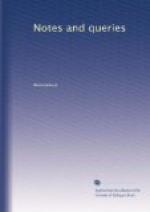[The story to which our correspondent alludes is, probably, that quoted in Cecil’s (Hone’s) Sixty Curious and Authentic Narratives, pp. 138-140., from the Recreations of a Man of Feeling. The peerage and the pedigree of the Stair family alike prove that there is little foundation for this ingenious fiction.]
Water-marks on Writing-paper (Vol. ii., p. 310.).—On this subject C., will, I think, find all the information he seeks in a paper published in the Aldine Magazine, (Masters, Aldersgate-st., 1839). This paper is accompanied by engravings of the ancient water-marks, as well as those of more modern times, and enters somewhat largely into the question of how far water-marks may be considered as evidence of precise dates. They are not always to be relied upon, for in December, 1850, there will doubtless be thousands of reams of paper issued and in circulation, bearing the date of 1851, unless the practice is altered of late years. Timperley’s Biographical, Chronological, and Historical Dictionary is much quoted on the subject of “Water-marks.”
E.B. PRICE.
St. John Nepomuc (Vol. ii., pp. 209. 317.).—The statues in honour of this Saint must be familiar to every one who has visited Bohemia, as also the spot of his martyrdom at Prague, indicated by some brass stars let into the parapet of the Steinerne Bruecke, on the right-hand side going from Prague to the suburb called the Kleinseite. As the story goes, he was offered the most costly bribes by Wenzel, king of Bohemia, to betray his trust, and after his repeated refusal was put to the torture, and then thrown into the Moldau, where he was drowned. The body of the saint was embalmed, and is now preserved in a costly silver shrine of almost fabulous worth, in the church of St. Veit, in the Kleinseite. In Weber’s Briefe eines durch Deutschland reisende Deutschen, the weight silver about this shrine is said to be twenty “centener.”
C.D. LAMONT.
Satirical Medals (Vol. ii., p. 298.).—A descriptive catalogue of British medals is preparing for the press, wherein all the satirical medals relating to the Revolution of 1688 will be minutely described and explained.
G.H.
Passage in Gray (Vol. i., p. 150.).—I see no difficulty in the passage about which your correspondent; A GRAYAN inquires. The abode of the merits and frailties of the dead, i.e. the place in which they are treasured up until the Judgment, is the Divine mind. This the poet, by a very allowable figure, calls “Bosom.” Homer’s expression is somewhat analogous.
[Greek: “Tade panta theion en gounasi keitai.”]
E.C.H.
Cupid Crying (Vol. i., pp. 172. 308.).—Another translation of the English verses, p. 172., which English are far superior to the Latin original:—
“Perchi ferisce Venere
Il filio suo che geme?
Diede il fanciullo a Celia
Le freccie e l’arco
insieme.




